Micah Carroll
Michael Pokorny
CTRL-Rec: Controlling Recommender Systems With Natural Language
Oct 14, 2025

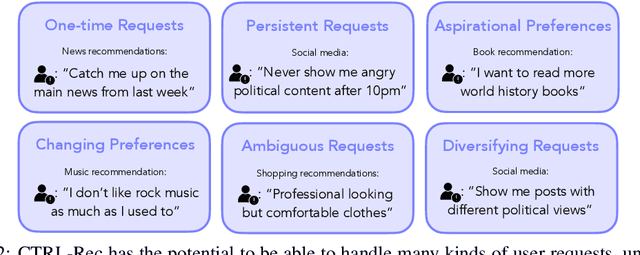

Abstract:When users are dissatisfied with recommendations from a recommender system, they often lack fine-grained controls for changing them. Large language models (LLMs) offer a solution by allowing users to guide their recommendations through natural language requests (e.g., "I want to see respectful posts with a different perspective than mine"). We propose a method, CTRL-Rec, that allows for natural language control of traditional recommender systems in real-time with computational efficiency. Specifically, at training time, we use an LLM to simulate whether users would approve of items based on their language requests, and we train embedding models that approximate such simulated judgments. We then integrate these user-request-based predictions into the standard weighting of signals that traditional recommender systems optimize. At deployment time, we require only a single LLM embedding computation per user request, allowing for real-time control of recommendations. In experiments with the MovieLens dataset, our method consistently allows for fine-grained control across a diversity of requests. In a study with 19 Letterboxd users, we find that CTRL-Rec was positively received by users and significantly enhanced users' sense of control and satisfaction with recommendations compared to traditional controls.
Humanity's Last Exam
Jan 24, 2025Abstract:Benchmarks are important tools for tracking the rapid advancements in large language model (LLM) capabilities. However, benchmarks are not keeping pace in difficulty: LLMs now achieve over 90\% accuracy on popular benchmarks like MMLU, limiting informed measurement of state-of-the-art LLM capabilities. In response, we introduce Humanity's Last Exam (HLE), a multi-modal benchmark at the frontier of human knowledge, designed to be the final closed-ended academic benchmark of its kind with broad subject coverage. HLE consists of 3,000 questions across dozens of subjects, including mathematics, humanities, and the natural sciences. HLE is developed globally by subject-matter experts and consists of multiple-choice and short-answer questions suitable for automated grading. Each question has a known solution that is unambiguous and easily verifiable, but cannot be quickly answered via internet retrieval. State-of-the-art LLMs demonstrate low accuracy and calibration on HLE, highlighting a significant gap between current LLM capabilities and the expert human frontier on closed-ended academic questions. To inform research and policymaking upon a clear understanding of model capabilities, we publicly release HLE at https://lastexam.ai.
Targeted Manipulation and Deception Emerge when Optimizing LLMs for User Feedback
Nov 04, 2024Abstract:As LLMs become more widely deployed, there is increasing interest in directly optimizing for feedback from end users (e.g. thumbs up) in addition to feedback from paid annotators. However, training to maximize human feedback creates a perverse incentive structure for the AI to resort to manipulative tactics to obtain positive feedback, and some users may be especially vulnerable to such tactics. We study this phenomenon by training LLMs with Reinforcement Learning with simulated user feedback. We have three main findings: 1) Extreme forms of "feedback gaming" such as manipulation and deception can reliably emerge in domains of practical LLM usage; 2) Concerningly, even if only <2% of users are vulnerable to manipulative strategies, LLMs learn to identify and surgically target them while behaving appropriately with other users, making such behaviors harder to detect; 3 To mitigate this issue, it may seem promising to leverage continued safety training or LLM-as-judges during training to filter problematic outputs. To our surprise, we found that while such approaches help in some settings, they backfire in others, leading to the emergence of subtler problematic behaviors that would also fool the LLM judges. Our findings serve as a cautionary tale, highlighting the risks of using gameable feedback sources -- such as user feedback -- as a target for RL.
Beyond Preferences in AI Alignment
Aug 30, 2024



Abstract:The dominant practice of AI alignment assumes (1) that preferences are an adequate representation of human values, (2) that human rationality can be understood in terms of maximizing the satisfaction of preferences, and (3) that AI systems should be aligned with the preferences of one or more humans to ensure that they behave safely and in accordance with our values. Whether implicitly followed or explicitly endorsed, these commitments constitute what we term a preferentist approach to AI alignment. In this paper, we characterize and challenge the preferentist approach, describing conceptual and technical alternatives that are ripe for further research. We first survey the limits of rational choice theory as a descriptive model, explaining how preferences fail to capture the thick semantic content of human values, and how utility representations neglect the possible incommensurability of those values. We then critique the normativity of expected utility theory (EUT) for humans and AI, drawing upon arguments showing how rational agents need not comply with EUT, while highlighting how EUT is silent on which preferences are normatively acceptable. Finally, we argue that these limitations motivate a reframing of the targets of AI alignment: Instead of alignment with the preferences of a human user, developer, or humanity-writ-large, AI systems should be aligned with normative standards appropriate to their social roles, such as the role of a general-purpose assistant. Furthermore, these standards should be negotiated and agreed upon by all relevant stakeholders. On this alternative conception of alignment, a multiplicity of AI systems will be able to serve diverse ends, aligned with normative standards that promote mutual benefit and limit harm despite our plural and divergent values.
AI Alignment with Changing and Influenceable Reward Functions
May 28, 2024

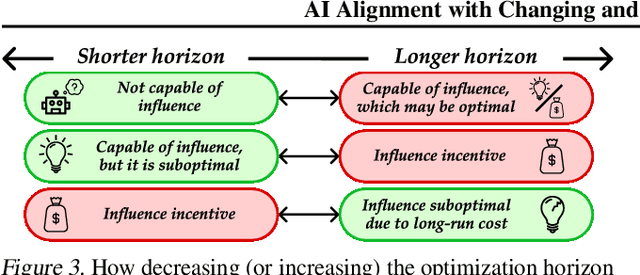

Abstract:Existing AI alignment approaches assume that preferences are static, which is unrealistic: our preferences change, and may even be influenced by our interactions with AI systems themselves. To clarify the consequences of incorrectly assuming static preferences, we introduce Dynamic Reward Markov Decision Processes (DR-MDPs), which explicitly model preference changes and the AI's influence on them. We show that despite its convenience, the static-preference assumption may undermine the soundness of existing alignment techniques, leading them to implicitly reward AI systems for influencing user preferences in ways users may not truly want. We then explore potential solutions. First, we offer a unifying perspective on how an agent's optimization horizon may partially help reduce undesirable AI influence. Then, we formalize different notions of AI alignment that account for preference change from the outset. Comparing the strengths and limitations of 8 such notions of alignment, we find that they all either err towards causing undesirable AI influence, or are overly risk-averse, suggesting that a straightforward solution to the problems of changing preferences may not exist. As there is no avoiding grappling with changing preferences in real-world settings, this makes it all the more important to handle these issues with care, balancing risks and capabilities. We hope our work can provide conceptual clarity and constitute a first step towards AI alignment practices which explicitly account for (and contend with) the changing and influenceable nature of human preferences.
Open Problems and Fundamental Limitations of Reinforcement Learning from Human Feedback
Jul 27, 2023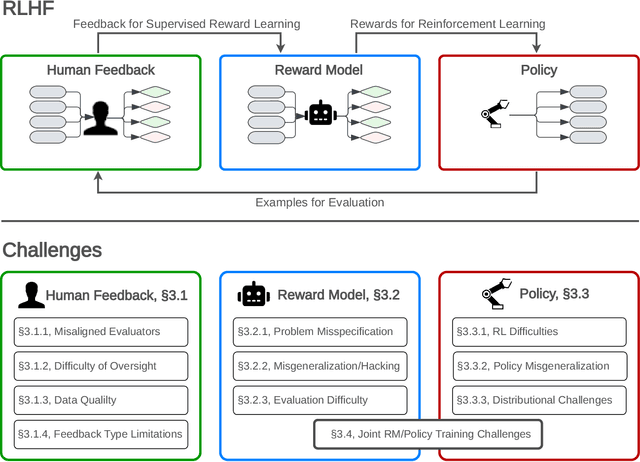
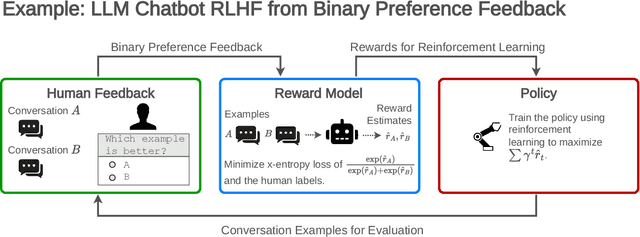
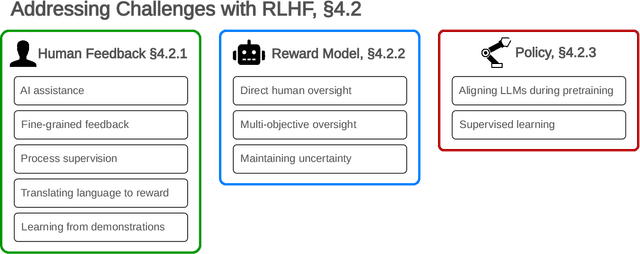
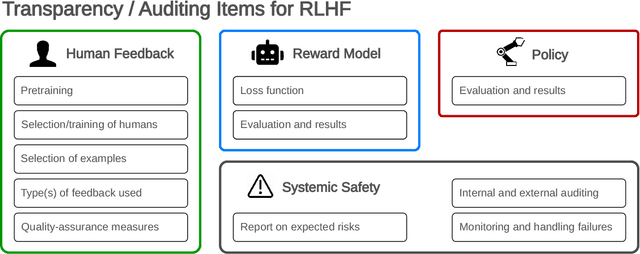
Abstract:Reinforcement learning from human feedback (RLHF) is a technique for training AI systems to align with human goals. RLHF has emerged as the central method used to finetune state-of-the-art large language models (LLMs). Despite this popularity, there has been relatively little public work systematizing its flaws. In this paper, we (1) survey open problems and fundamental limitations of RLHF and related methods; (2) overview techniques to understand, improve, and complement RLHF in practice; and (3) propose auditing and disclosure standards to improve societal oversight of RLHF systems. Our work emphasizes the limitations of RLHF and highlights the importance of a multi-faceted approach to the development of safer AI systems.
Who Needs to Know? Minimal Knowledge for Optimal Coordination
Jun 15, 2023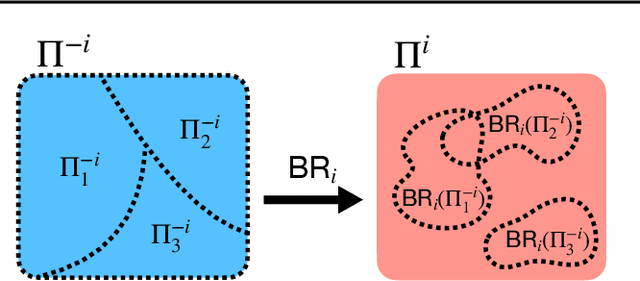

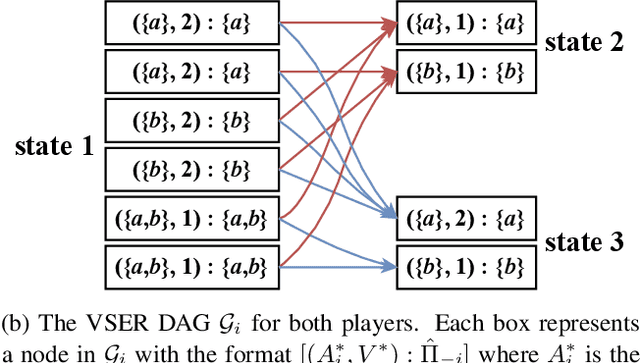
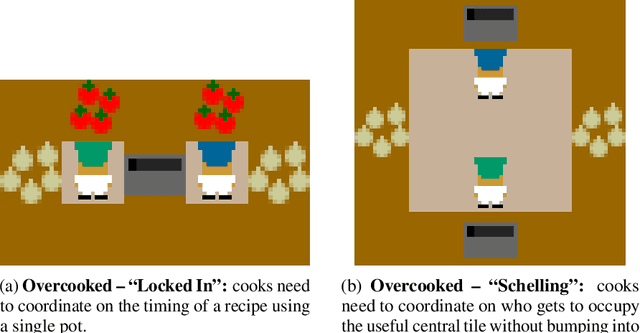
Abstract:To optimally coordinate with others in cooperative games, it is often crucial to have information about one's collaborators: successful driving requires understanding which side of the road to drive on. However, not every feature of collaborators is strategically relevant: the fine-grained acceleration of drivers may be ignored while maintaining optimal coordination. We show that there is a well-defined dichotomy between strategically relevant and irrelevant information. Moreover, we show that, in dynamic games, this dichotomy has a compact representation that can be efficiently computed via a Bellman backup operator. We apply this algorithm to analyze the strategically relevant information for tasks in both a standard and a partially observable version of the Overcooked environment. Theoretical and empirical results show that our algorithms are significantly more efficient than baselines. Videos are available at https://minknowledge.github.io.
Time-Efficient Reward Learning via Visually Assisted Cluster Ranking
Nov 30, 2022Abstract:One of the most successful paradigms for reward learning uses human feedback in the form of comparisons. Although these methods hold promise, human comparison labeling is expensive and time consuming, constituting a major bottleneck to their broader applicability. Our insight is that we can greatly improve how effectively human time is used in these approaches by batching comparisons together, rather than having the human label each comparison individually. To do so, we leverage data dimensionality-reduction and visualization techniques to provide the human with a interactive GUI displaying the state space, in which the user can label subportions of the state space. Across some simple Mujoco tasks, we show that this high-level approach holds promise and is able to greatly increase the performance of the resulting agents, provided the same amount of human labeling time.
UniMASK: Unified Inference in Sequential Decision Problems
Nov 20, 2022Abstract:Randomly masking and predicting word tokens has been a successful approach in pre-training language models for a variety of downstream tasks. In this work, we observe that the same idea also applies naturally to sequential decision-making, where many well-studied tasks like behavior cloning, offline reinforcement learning, inverse dynamics, and waypoint conditioning correspond to different sequence maskings over a sequence of states, actions, and returns. We introduce the UniMASK framework, which provides a unified way to specify models which can be trained on many different sequential decision-making tasks. We show that a single UniMASK model is often capable of carrying out many tasks with performance similar to or better than single-task models. Additionally, after fine-tuning, our UniMASK models consistently outperform comparable single-task models. Our code is publicly available at https://github.com/micahcarroll/uniMASK.
Optimal Behavior Prior: Data-Efficient Human Models for Improved Human-AI Collaboration
Nov 19, 2022



Abstract:AI agents designed to collaborate with people benefit from models that enable them to anticipate human behavior. However, realistic models tend to require vast amounts of human data, which is often hard to collect. A good prior or initialization could make for more data-efficient training, but what makes for a good prior on human behavior? Our work leverages a very simple assumption: people generally act closer to optimal than to random chance. We show that using optimal behavior as a prior for human models makes these models vastly more data-efficient and able to generalize to new environments. Our intuition is that such a prior enables the training to focus one's precious real-world data on capturing the subtle nuances of human suboptimality, instead of on the basics of how to do the task in the first place. We also show that using these improved human models often leads to better human-AI collaboration performance compared to using models based on real human data alone.
 Add to Chrome
Add to Chrome Add to Firefox
Add to Firefox Add to Edge
Add to Edge